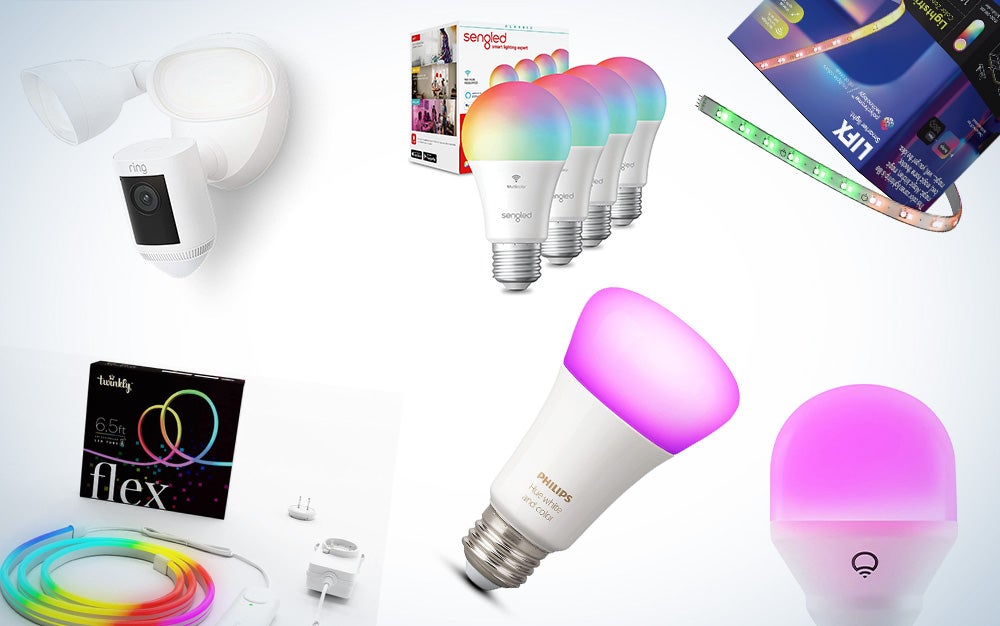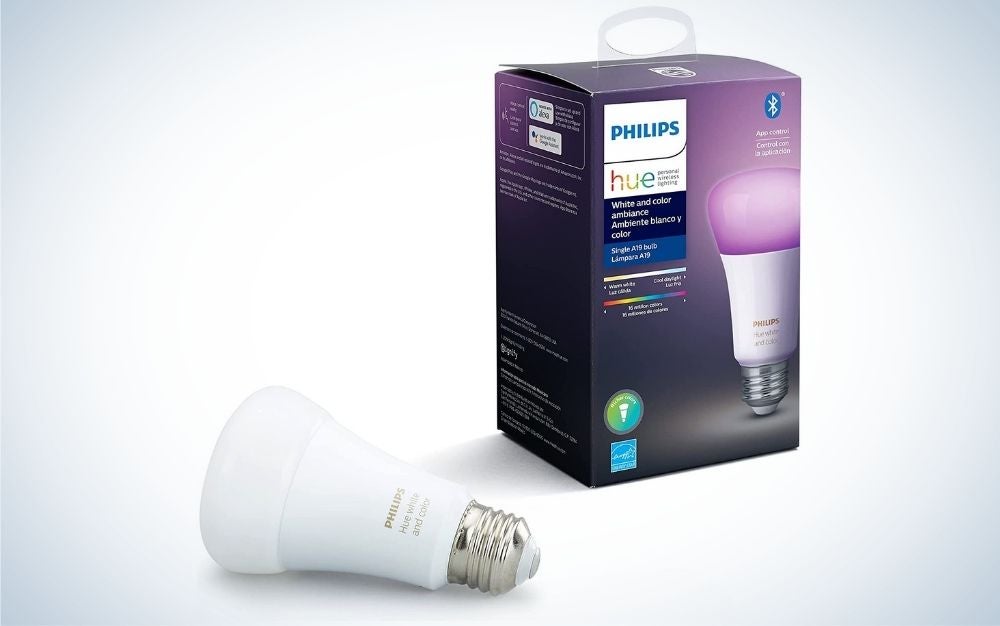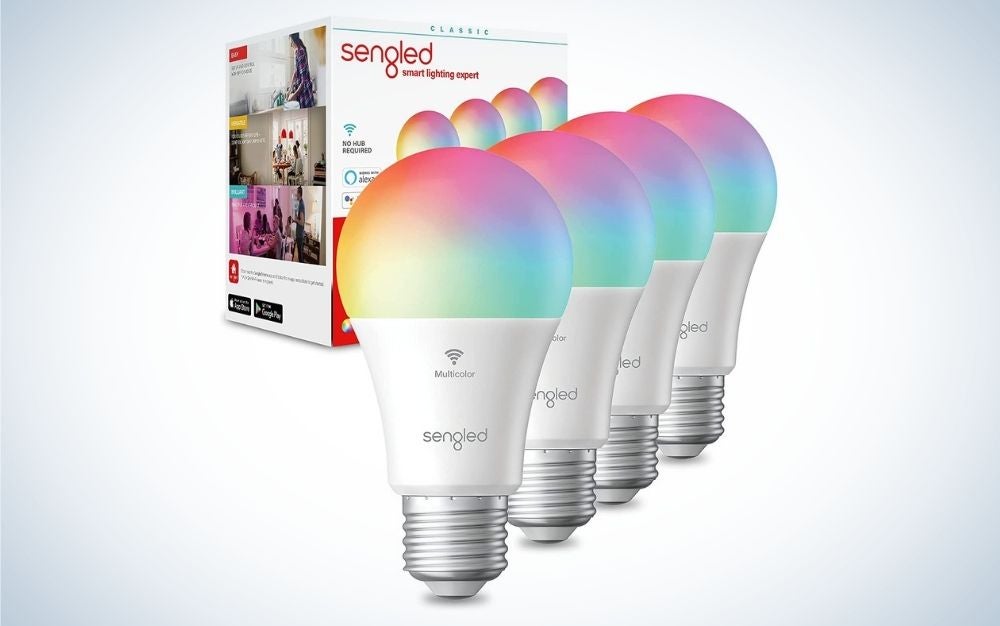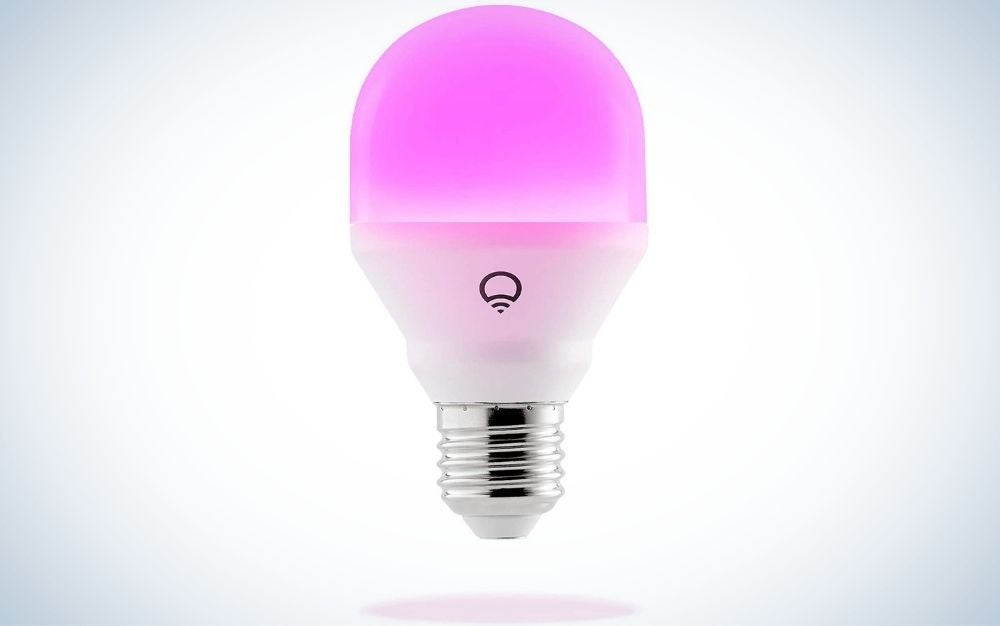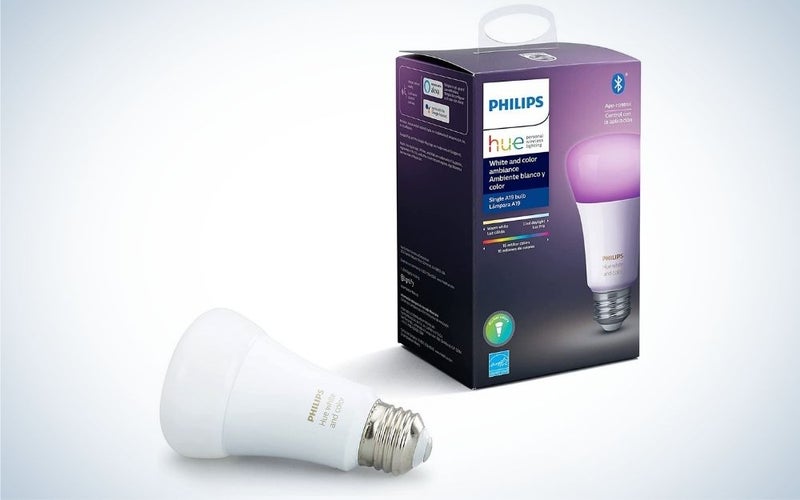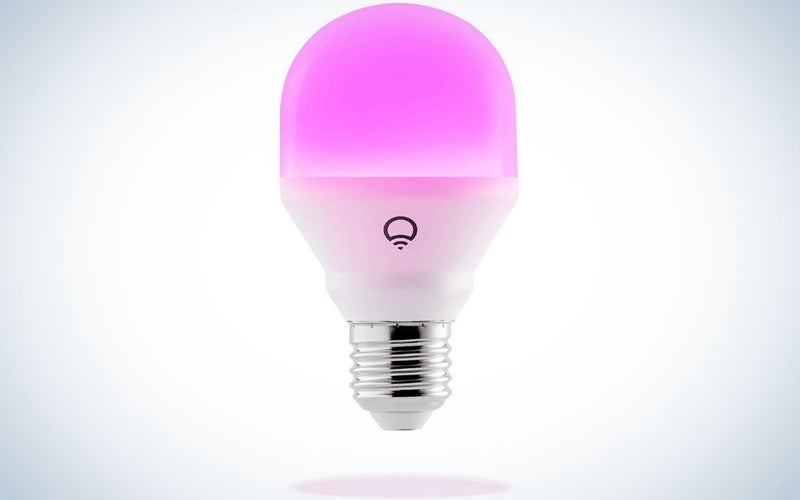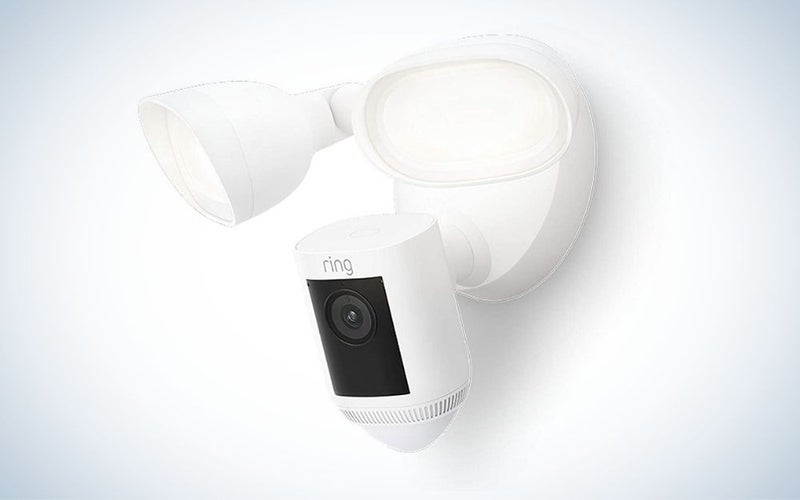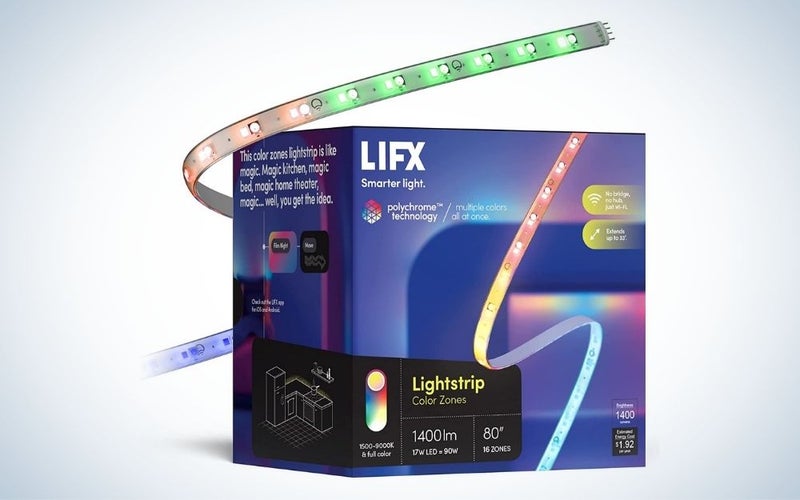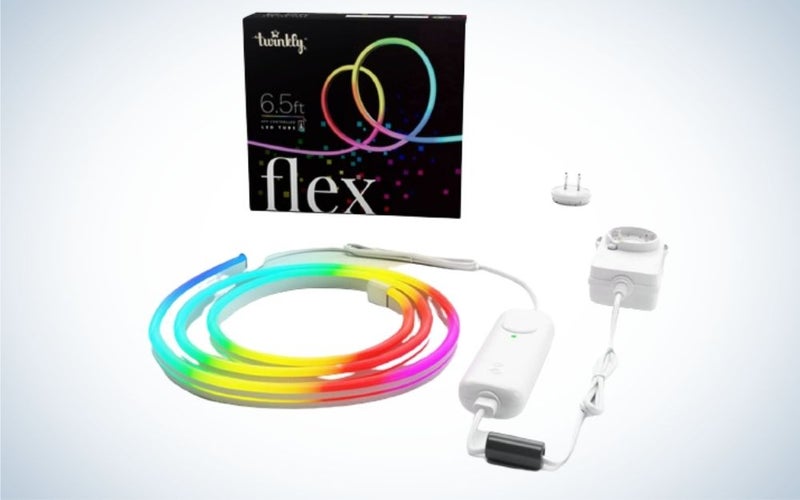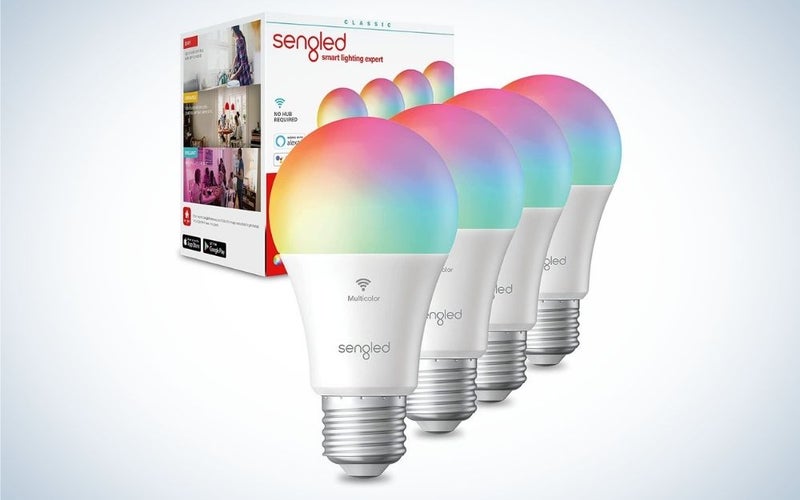We may earn revenue from the products available on this page and participate in affiliate programs. Learn more ›
The best smart lights can easily shift both the mood and function of a room. They can make it a brightly lit work or study spot one moment, and a cozy personal oasis the next. Smartphone apps and voice assistants make controlling them simple. And a single bulb can pump out different colors and quantities of light to dictate the vibe in your space. There are models that can enhance home security, and then there are the best light strips that provide practicality or allow you to express your creativity. The options can be dizzying. And because LED lights have greater lifespans and energy efficiency and produce fewer emissions, making them a far more environmentally beneficial choice than incandescent lighting, using them is smart in more than one way. In the following article, we discuss the key technical specifications that need to be considered and look at a selection of the best smart lights currently available.
- Best overall: Philips Hue A19 Smart Light Bulb
- Best with no hub: LIFX Mini
- Best for outdoors: Ring Floodlight Cam
- Best light strips: LIFX Lightstrip
- Best for getting creative: Twinkly Flex
- Best budget: Sengled A19
How we selected the best smart lights
While researching the best smart lights we looked at dozens of different products, many of them very similar. Although the technical specifications are certainly an important feature, we also used the following criteria in making our selection.
- Simplicity: Taking full advantage of smart lights requires more than simply screwing it in. However, if set up and control are a hassle, then people are less likely to access their full functionality. We looked for models that made this as easy as possible.
- Options: While smart lights that replace existing incandescent bulbs are the most popular option, there are also strip lights for decorative use, and smart security lighting that helps protect your home. Including these in our choices gives a greater awareness of possible smart light usage.
- Value: While we have focussed on well-known brands to ensure reliable performance, we have also made sure to include products for different budgets.
The final evaluations come from a mix of in-depth online research and personal hands-on experience with the various smart lighting platforms.
Things to consider before buying a smart light
The best smart lights offer a high level of flexibility so it’s important to have a basic understanding of their specifications. While the jargon can seem a little confusing at first, the following should provide an easy-to-use explanation of the key features.
Lumens and Watts
In a nutshell, Lumens (LM) translates into brightness. Higher numbers are brighter. While Watts (W) has been used for many years, those figures are actually a measure of energy consumption. Direct comparisons are difficult because of the differences between the way filaments (used in incandescent bulbs) and LEDs (used in smart lights) work. 800LM is probably the most common smart light bulb replacement and is equivalent to approximately 60W, while 1600LM is roughly equivalent to 100W.
Watts are still used but now for their proper purpose, as an indicator of the amount of electricity a smart light uses. Lower numbers mean a better economy.
Hue or color
Even the most basic of smart lights produce more than simply white light, with the ability to change the hue, or ‘whiteness’, from cool to warm depending on mood. It might also be possible to automate it to change as the natural light changes throughout the day. Whiteness (also called color temperature) is rated by Kelvin (k) and can be anywhere from around 1500k to 10000k.
Most smart lights offer millions or even billions of color options. However, given that the human eye can only recognize a few million colors, anything above this makes no significant difference. It’s worth pointing out that while color change is common, it is worth checking whether the light can be dimmed as this is not always the case. If you’re interested in integrating more colorful lighting into your space, you can also consider our top recommendations of LED light strips that can be attached to furniture, TVs, PCs, and car interiors.
CRI (Color Rendering Index) will sometimes appear in the listings or packaging. The color something looks when lit by any bulb is never exactly the same as when lit by natural light. CRI measures how close to natural light it is, with a CRI of 100 being perfect, 90 CRI excellent, and 80 CRI and above considered good.
Life expectancy
Even low-cost smart lights can last upwards of 20,000 hours. Even if left on 8 hours a day, every day of the week, that’s almost 7 years. Some can last twice that, or even longer.
Connectivity and features
Because smart lights connect to the internet, they can actually get smarter over time. That means new features and functionalities. It is worth spending time understanding both the features on offer, and how they are accessed. Smartphone operation via Bluetooth is usually the most basic option. Voice control via Alexa, Google Assistant, or Apple HomeKit is possible, although an extra hub from the manufacturer may be required. That can have a significant impact on the price.
The best smart lights: Reviews & Recommendations
Best overall: Philips Hue
Philips Hue
Why it made the cut: Philips Hue smart lights offer great all-around performance. While they don’t require a hub, adding one provides one of the most comprehensive feature sets on the market.
Specs:
- Lumens: 800
- Power consumption: 10W
- Lifetime: 25,000 hours
Pros:
- Easy to install and use
- Control via Bluetooth app
- Dimmable, with wide color and white ranges
Cons:
- Requires hub for full feature set
- Relatively expensive
Philips Hue smart lights are one of the most popular choices on the market. The company’s white models are very affordable, while its color-changing models provide tremendous versatility.
Built-in Bluetooth connectivity allows them to operate without a hardware hub if you prefer simplicity over functionality. Using the smartphone app they are quick and easy to set up. White variation runs from 2000k to 6500k. One-touch mood buttons with names like ‘concentrate’, ‘read’, and ‘relax’ offer quick access to specific looks that can sync across multiple bulbs. Their color range includes roughly 16 million different hues.
Using Bluetooth does have limits. It theoretically offers a range of 40 feet, but walls usually block the signal so you need to be in the same room as the light. Bluetooth also maxes out the number of connected lights at 10. The solution is to add the optional WiFi hub. This extends the feature set considerably. Up to 50 smart lights can be controlled, from anywhere. Timers can be set for the entire home. It also integrates with Alexa, Google Assistant, or Apple HomeKit for voice control.
Once you’re using the hub, you won’t find a more complete and full-featured smart light platform, as Philips made some of the best smart bulbs.
Best with no hub: LIFX Mini
Amazon
Why it made the cut: While designed for smaller fittings, it still offers a very impressive feature set.
Specs:
- Lumens: 800
- Power consumption: 9W
- Lifetime: 25,000 hours
Pros:
- No hub required
- Ideal for lamps and smaller light fittings
- Multiple integration options
Cons:
- Setup can be frustrating
- Expensive
The LIFX Mini model provides the ideal solution for desk lamps, table lamps, or other light fittings where a standard-sized bulb looks ungainly. Even with its small size, it still emits a pleasantly surprising amount of light.
Each LIFX Mini bulb benefits from built-in WiFi so there’s no need for any kind of hub. Voice control works with all the major smart home platforms, including Alexa, Google Assistant, Apple HomeKit, and Samsung SmartThings. They will also integrate with Arlo home security, and IFTTT systems.
White range is 2500k to 9000k, and 16 million colors can be selected. The smartphone app can be frustrating to set up, often requiring several attempts to identify lights. It does, however, offer a tremendous range of features. In addition, to control from anywhere, it offers individual or group settings, timers, a wide range of ‘mood’ themes, and the ability to design and store your own.
Best for outdoors: Ring Floodlight Cam
Ring
Why it made the cut: This smart, outdoor light is a very smart solution that can improve your home security, providing multiple access and control features.
Specs:
- Lumens: 2000
- Power consumption: 24W
- Lifetime: Quoted as ’10 years with normal usage’
Pros:
- Two-way communication
- Color night vision
- Customizable zones reduce false alerts
Cons:
- Subscription required for video storage
- LED bulbs are non-replaceable
Lighting the outside of your home has long been recognized as an effective way to increase security. Motion sensors will often deter the thief who thinks they are sneaking up, only to be suddenly illuminated. The Ring Floodlight Cam takes this idea and improves on it by enabling real-time viewing and the option for video recording.
Connectivity via the internet means the camera feed can be viewed by smartphone anywhere, at any time. An alert can be sent if a motion is detected. 1080HD resolution and color night vision, combined with 2000 lumen LEDs ensure a bright, clear image. If the cam is connected to Alexa, two-way communications are also possible. A 110-decibel alarm can be activated remotely if necessary. Custom motion zones highlight user-defined areas and minimize false activation by stray animals for example.
There is one area where improvement could be made, and it concerns the LED lights themselves. Currently, these cannot be changed independently. Although expected to last up to ten years, when they do fail, the entire unit needs to be replaced.
Best light strips: LIFX Lightstrip
LIFX
Why it made the cut: LIFX Lightstrips bring new versatility to how people light their homes. These smart light strips can be positioned virtually anywhere and offer wide-ranging integration with control and security systems.
Specs:
- Lumens: 1400
- Power consumption: 17W
- Lifetime: 20,000 hours
Pros:
- Highly versatile effects lighting
- No hub required
- Can be shortened or extended
Cons:
- Expensive
- No 5GHz support
The LIFX Lightstrip provides remarkable versatility in terms of positioning, allowing you to put smart lighting virtually anywhere. This flexible, 80-inch strip sports an adhesive backing that will stick to almost anything. It’s simple to cut or add more strips to give it a total length of up to 33 feet by combining multiples.
Lighting performance is equally impressive. The “white” range pushes the boundaries from a super-warm 1500k to a super-cool 9000k and it claims to offer billions of colors. The strip as a whole can be set to a single tone but is composed of 16 zones that can be activated or animated individually. The potential for vibrant lighting is almost unlimited, and LIFX provides a library of effects via the smartphone app.
Provision of 2.4GHz Wi-Fi means no hub is required, though 5GHz is not supported. LIFX Lightstrip works with Alexa, Google Assistant, Apple HomeLink, and Samsung SmartThings. It can also integrate with Xfinity Home security motion detectors, and via IFTTT can flash when a Uber arrives.
Best for getting creative: Twinkly Flex
LEDworks
Why it made the cut: Although Twinkly Flex can be used as room lighting, its real benefit is as a feature or focal point that can even interact with those around it.
Specs:
- Lumens: Not available
- Power consumption: 15W
- Lifetime: 30,000 hours
Pros:
- Tremendous flexibility
- Virtually unlimited effects
- No hub required
Cons:
- Cannot be extended
- Power cable can be intrusive
Twinkly Flex is a 6-foot, 6-inch strip containing 192 LED. Each strip comes with 16 clips that can be attached either with the included adhesive strips or with nails. It is Wi-Fi-enabled so there’s no need for a hub, and it integrates easily with Alexa and Google Assistant. It is perfectly feasible to use it as under-surface lighting in a kitchen or bedroom. The main purpose of Twinkly Flex is to create dramatic and dynamic lighting effects.
These are controlled via the smartphone app, which offers an extensive library of presets, or the FX Wizard can be used to create something unique. An optional Twinkly microphone can make the lights react to a voice. It can also integrate with Razer’s Chroma platform, so the lights around your room can sync with the RGB illumination on your gaming gear like keyboards, headsets, and mice.
Two or more Twinkly Flex units can be paired together under the same control, but not physically attached to each other. If mounted on a colored wall, the white power cable can seem a little obtrusive.
Best budget: Sengled A19
Sengled
Why it made the cut: Sengled’s budget-friendly smart lights offer many of the features provided by more expensive brands, and have built-in WiFi so they don’t require a hub.
Specs:
- Lumens: 800
- Power consumption: 9W
- Lifetime: 25,000 hours
Pros:
- No hub required
- Good white and color ranges
- Great value
Cons:
- Limited control and integration options
Each Sengled smart light has its own Wi-Fi antenna built in, so the bulbs don’t need a hardware hub. They simply hook up directly to any 2.4GHz home internet network (5GHz is not supported). The straightforward setup process only takes a few minutes and grants access to all the basic controls over brightness and color.
The bulb’s neutral modes range from a warm 2000k to a sunlight-emulating 6500k. It also offers 16 million different colors. With some low-cost models, light projection can be poor. That’s not the case with the Sengled smart lights which do a good job of spreading the chosen mood throughout the room.
Voice control works with Alexa, Google Assistant, and Samsung SmartThings, though Sengled smart lights do not integrate with Apple HomeKit. The app enables some advanced features including the ability to monitor energy consumption. Users can also schedule wake and sleep modes so the lights brighten or dim over an extended period. While they don’t offer the complexity or wide-ranging integration of the Philips Hue, the comparatively low price makes them a popular alternative.
FAQs
Q: What is the brightest smart light?
At 1600 Lumens, the Feit Electric OM100 is the brightest light we found, though it’s worth reiterating that brightness is only one of the considerations when choosing the best smart lights.
Q: Are smart LED lights worth it?
Figures from the US Department of Energy tell us smart lights use only around a quarter of the energy of standard incandescent bulbs. So although they cost more initially, they definitely save money over their lifetime.
Q: Do smart bulbs work without Wi-Fi?
Many will work with Bluetooth alone, though functionality may be less than when combined with a hub or home automation system that relies on Wi-Fi. It’s important to check the specifications of each model.
Final thoughts on the best smart lights
The best smart lights can be as simple as a single mood bulb or provide lighting control over the entire home. This is typically the first smart home purchase people make and for good reason. They’re fun and functional. They can also save you money in the long run.
